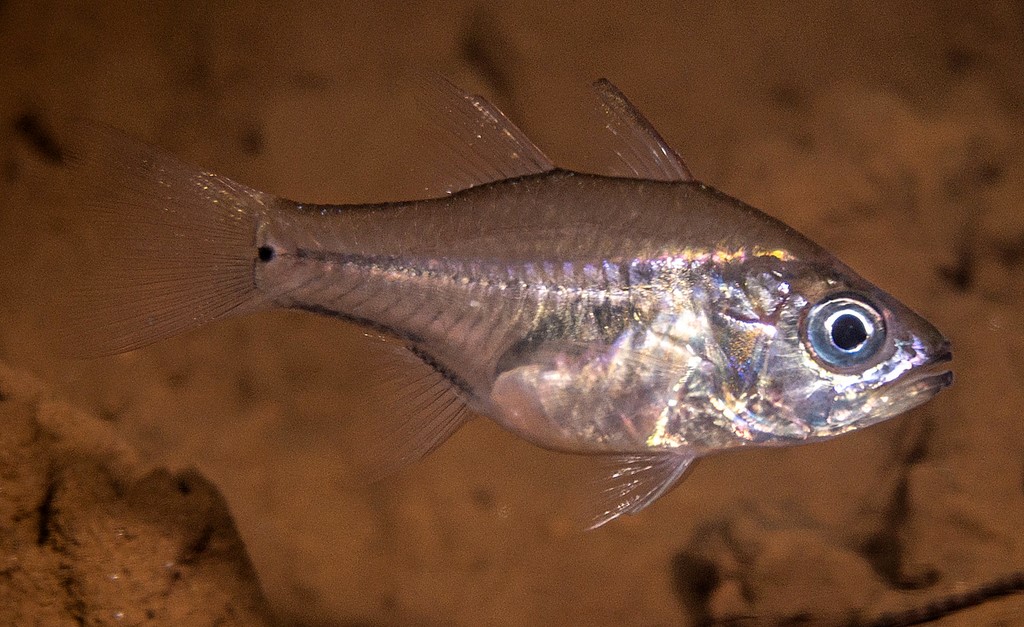FIBRAMIA AMBOINENSIS - (BLEEKER, 1853)
Picture courtesy of: Damien Brouste
Actinopterygii (Gigaclass) > Actinopteri (Class) > Teleostei (Subclass) > Gobiiformes (Order) > Apogonoidei (Suborder) > Apogonidae (Family) > Apogoninae (Subfamily) > Fibramia (Genus)
Amboina cardinalfish, Amami ishimochi, アマミイシモチ, 弓線天竺鯛, Cá Sơn bắp đuôi chấm,
Synonymes
Apogon amboinensis (Bleeker, 1853)
Ostorhinchus amboinensis (Bleeker, 1853)
--------------------------
Description
Dorsal spines (total): 7; Dorsal soft rays (total): 9; Anal spines: 2; Anal soft rays: 8; Pectoral fin rays: 14; Pelvic fin rays: I, 5; Pored lateral line scales: 24; Predorsal scales 7; Circumpeduncular scales: 12; Total gill rakers: 21-22, developed gill rakers: 19-20. Max. length: 7.0 cm SL. Depth range: 2 - 5 m.
Color
Light brown body; Two black stripes, one from snout to opercular margin through eye, and the second one on anterior portion of lateral line; Blackish anterior part of first dorsal fin; Base of caudal fin with distinct black spot.
Etymology
Fibramia: from Latin, fibra = fiber, filament + from Greek, amia, -as = a kind of bonito. Name given by Aristotle to a fish (Later name applied to Apogon by Gronow (1763), now a commonly used suffix in the family). Referring to two characteristics of the species in this genus, an elongate second dorsal spine in one species (Fibramia thermalis) and the narrow, pale or dark mid-line on the body of two species (Fibramia amboinensis and Fibramia lateralis).
amboinensis: named for Ambon Island. Ambon Island is part of the Maluku Islands of Indonesia.
Original description: Apogon amboinensis Bleeker, 1853 - Type locality: Ambon Island, Molucca Islands, Indonesia.
Distribution
Western Pacific: New Caledonia, Philippines to Papua New Guinea, north to southern Japan.
Biology
Found in brackish water at river mouths and among the mangroves. Also enters freshwater during low tide. Mouth brooding by males. Distinct pairing during courtship and spawning.
Similar species
Apogon ceramensis (Bleeker, 1852) - Reported from Indonesia, Papua New Guinea to Philippines. Silvery to slight golden sheen coloration; A narrow dark midlateral stripe; Black-edged first dorsal fin and a small black spot at the middle of caudal-fin base. It is similar to Fibramia lateralis but generally smaller (max. length: 8.0 cm TL) and the female has a small black spot behind the eye.
Actinopterygii (Gigaclass) > Actinopteri (Class) > Teleostei (Subclass) > Gobiiformes (Order) > Apogonoidei (Suborder) > Apogonidae (Family) > Apogoninae (Subfamily) > Fibramia (Genus)
Amboina cardinalfish, Amami ishimochi, アマミイシモチ, 弓線天竺鯛, Cá Sơn bắp đuôi chấm,
Synonymes
Apogon amboinensis (Bleeker, 1853)
Ostorhinchus amboinensis (Bleeker, 1853)
--------------------------
Description
Dorsal spines (total): 7; Dorsal soft rays (total): 9; Anal spines: 2; Anal soft rays: 8; Pectoral fin rays: 14; Pelvic fin rays: I, 5; Pored lateral line scales: 24; Predorsal scales 7; Circumpeduncular scales: 12; Total gill rakers: 21-22, developed gill rakers: 19-20. Max. length: 7.0 cm SL. Depth range: 2 - 5 m.
Color
Light brown body; Two black stripes, one from snout to opercular margin through eye, and the second one on anterior portion of lateral line; Blackish anterior part of first dorsal fin; Base of caudal fin with distinct black spot.
Etymology
Fibramia: from Latin, fibra = fiber, filament + from Greek, amia, -as = a kind of bonito. Name given by Aristotle to a fish (Later name applied to Apogon by Gronow (1763), now a commonly used suffix in the family). Referring to two characteristics of the species in this genus, an elongate second dorsal spine in one species (Fibramia thermalis) and the narrow, pale or dark mid-line on the body of two species (Fibramia amboinensis and Fibramia lateralis).
amboinensis: named for Ambon Island. Ambon Island is part of the Maluku Islands of Indonesia.
Original description: Apogon amboinensis Bleeker, 1853 - Type locality: Ambon Island, Molucca Islands, Indonesia.
Distribution
Western Pacific: New Caledonia, Philippines to Papua New Guinea, north to southern Japan.
Biology
Found in brackish water at river mouths and among the mangroves. Also enters freshwater during low tide. Mouth brooding by males. Distinct pairing during courtship and spawning.
Similar species
Apogon ceramensis (Bleeker, 1852) - Reported from Indonesia, Papua New Guinea to Philippines. Silvery to slight golden sheen coloration; A narrow dark midlateral stripe; Black-edged first dorsal fin and a small black spot at the middle of caudal-fin base. It is similar to Fibramia lateralis but generally smaller (max. length: 8.0 cm TL) and the female has a small black spot behind the eye.
Fibramia lateralis (Valenciennes, 1832) - Reported from New Caledonia - Link to the species (here). Fibramia amboinensis similar to Fibramia lateralis but head profile concave versus convex aboves eyes.
Last update: 14, September 2023
Last update: 14, September 2023
